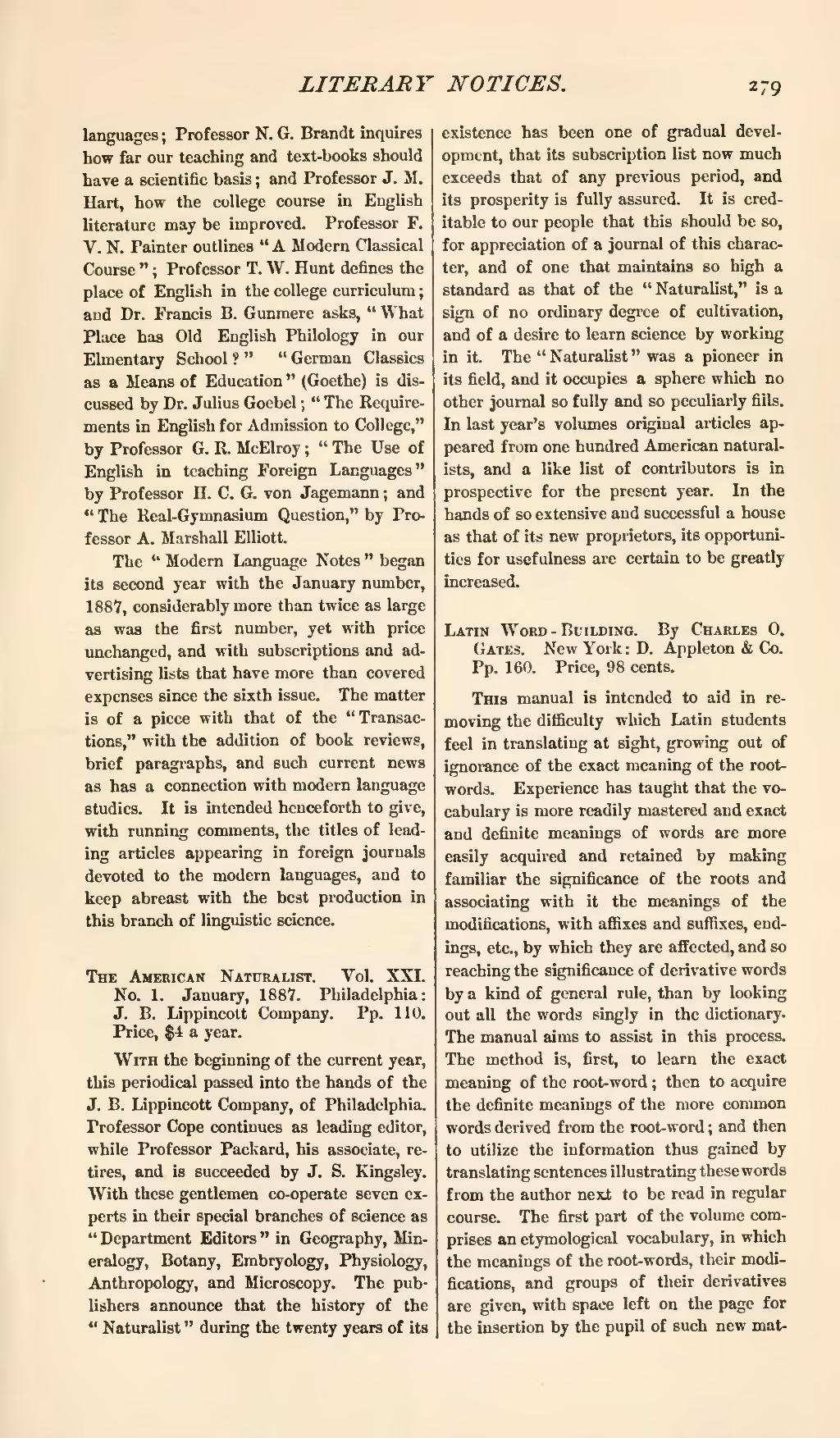languages; Professor N. G. Brandt inquires how far our teaching and text-books should have a scientific basis; and Professor J. M. Hart, how the college course in English literature may be improved. Professor F. V. N. Painter outlines "A Modern Classical Course"; Professor T. W. Hunt defines the place of English in the college curriculum; and Dr. Francis B. Gunmere asks, "What Place has Old English Philology in our Elmentary School?" "German Classics as a Means of Education"(Goethe) is discussed by Dr. Julius Goebel;" The Requirements in English for Admission to College," by Professor G. R. McElroy; "The Use of English in teaching Foreign Languages" by Professor H. C. G. von Jagemann; and "The Real-Gymnasium Question," by Professor A. Marshall Elliott.
The "Modern Language Notes" began its second year with the January number, 1887, considerably more than twice as large as was the first number, yet with price unchanged, and with subscriptions and advertising lists that have more than covered expenses since the sixth issue. The matter is of a piece with that of the "Transactions," with the addition of book reviews, brief paragraphs, and such current news as has a connection with modern language studies. It is intended henceforth to give, with running comments, the titles of leading articles appearing in foreign journals devoted to the modern languages, and to keep abreast with the best production in this branch of linguistic science.
The American Naturalist. Vol. XXI. No. 1. January, 1887. Philadelphia: J. B. Lippincott Company. Pp. 110. Price, $4 a year.
With the beginning of the current year, this periodical passed into the hands of the J. B. Lippincott Company, of Philadelphia. Professor Cope continues as leading editor, while Professor Packard, his associate, retires, and is succeeded by J. S. Kingsley. With these gentlemen co-operate seven experts in their special branches of science as "Department Editors" in Geography, Mineralogy, Botany, Embryology, Physiology, Anthropology, and Microscopy. The publishers announce that the history of the "Naturalist" during the twenty years of its existence has been one of gradual development, that its subscription list now much exceeds that of any previous period, and its prosperity is fully assured. It is creditable to our people that this should be so, for appreciation of a journal of this character, and of one that maintains so high a standard as that of the "Naturalist," is a sign of no ordinary degree of cultivation, and of a desire to learn science by working in it. The "Naturalist" was a pioneer in its field, and it occupies a sphere which no other journal so fully and so peculiarly fills. In last year's volumes original articles appeared from one hundred American naturalists, and a like list of contributors is in prospective for the present year. In the hands of so extensive and successful a house as that of its new proprietors, its opportunities for usefulness are certain to be greatly increased.
Latin Word-Building. By Charles O. Gates. New York: D. Appleton & Co. Pp. 160. Price, 98 cents.
This manual is intended to aid in removing the difficulty which Latin students feel in translating at sight, growing out of ignorance of the exact meaning of the root-words. Experience has taught that the vocabulary is more readily mastered and exact and definite meanings of words are more easily acquired and retained by making familiar the significance of the roots and associating with it the meanings of the modifications, with affixes and suffixes, endings, etc., by which they are affected, and so reaching the significance of derivative words by a kind of general rule, than by looking out all the words singly in the dictionary. The manual aims to assist in this process. The method is, first, to learn the exact meaning of the root-word; then to acquire the definite meanings of the more common words derived from the root-word; and then to utilize the information thus gained by translating sentences illustrating these words from the author next to be read in regular course. The first part of the volume comprises an etymological vocabulary, in which the meanings of the root-words, their modifications, and groups of their derivatives are given, with space left on the page for the insertion by the pupil of such new mat-
